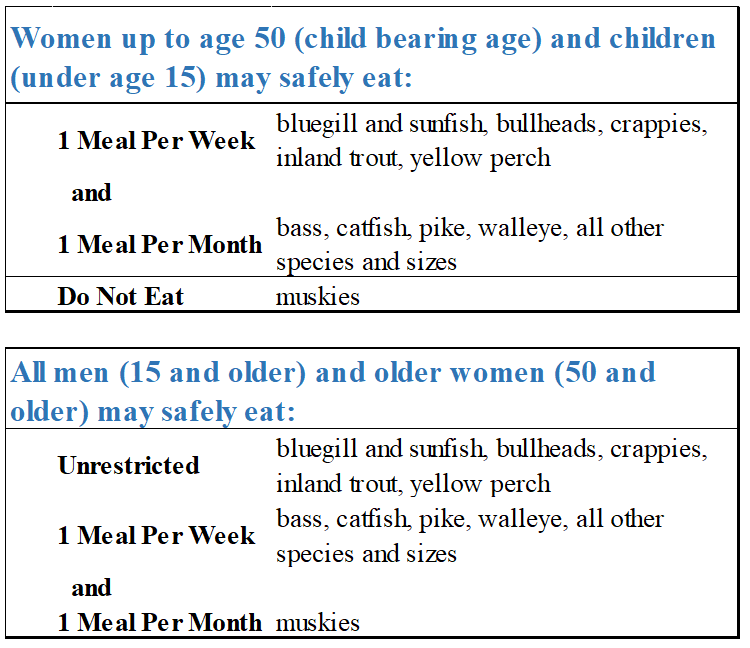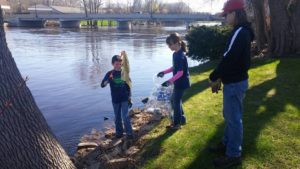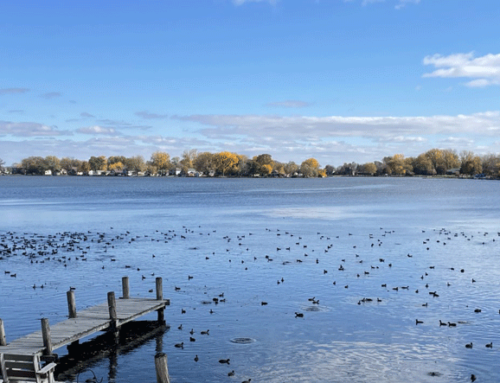Microbeads and other microplastics have recently received lots of attention in local news media. A recent study found microplastics in Lake Winnebago and folks are curious to know if this is something they should be concerned about. This is understandable considering over 250,000 people receive their drinking water from the lake while many more people use the Winnebago System for fishing and recreation opportunities.
What are microplastics?
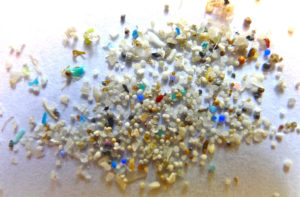
Picture of microplastics from Oregon State University
Numerous studies over the past few years have identified microbeads, microplastics and microfibers as pollutants of emerging concern. Microplastics are small particles of synthetic material, less than 5 micro-meters in size (smaller than a sesame seed). Microbeads and microfibers are both types of microplastics. Microbeads have been used in many health and beauty products including soaps (such as facewash) and some toothpastes. Microfibers, evens smaller than microbreads (< 1mm in size), typically come from the breakdown of products made up of plastic such as plastic bags, bottles, fishing line and synthetic clothing. Synthetic clothing is made from man-made materials such as polyester, nylon, spandex, rayon, among others.
How do microplastics get into our lakes?
Microplastics end up in our lakes through a variety of ways including surface water runoff, plastic garbage that breaks down in the water over time, and direct discharge from wastewater pipes. 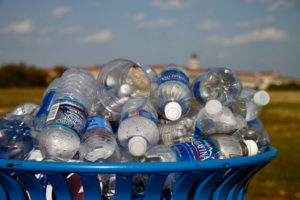 It should not be surprising that a recent study by the University of Wisconsin-Superior and the Fond du Lac Waster Treatment Facility found microbeads, microfibers and other microplastics in Lake Winnebago, Wisconsin’s largest freshwater lake. Many communities surrounding Lake Winnebago discharge treated wastewater into the lake. Typical wastewater treatment facilities are not equipped to remove these extremely small pieces of synthetic material. According to Autumn Fisher from the Fond du Lac Wastewater Treatment and Resource Recovery Facility (WTRRF), the upgrades needed in order to filter out these pollutants would be very costly.
It should not be surprising that a recent study by the University of Wisconsin-Superior and the Fond du Lac Waster Treatment Facility found microbeads, microfibers and other microplastics in Lake Winnebago, Wisconsin’s largest freshwater lake. Many communities surrounding Lake Winnebago discharge treated wastewater into the lake. Typical wastewater treatment facilities are not equipped to remove these extremely small pieces of synthetic material. According to Autumn Fisher from the Fond du Lac Wastewater Treatment and Resource Recovery Facility (WTRRF), the upgrades needed in order to filter out these pollutants would be very costly.

Photo credit: Katerha
Why are microplastics a problem?
Once microplastics break down to a small enough size, the particles do not decompose any further and end up accumulating in our waterways. Some studies have shown that these small plastic particles can be ingested by fish, birds and other aquatic animals. Once ingested, microplastics can cause physical harm to the animal by blocking the digestive track or causing internal abrasions. Some experts believe microplastics may pose risks to the aquatic ecosystems and human health because additives added to plastics are often found in these tiny plastics. Other contaminants that cling to these particles, such as pathogens, trace metals and pesticides, may also pose some risk. According to Sarah Yang, Ph.D., from the Wisconsin Department of Natural Resources, some studies have suggested that microplastics may be able to increase the mobility of certain pollutants. While there is potential for adverse impact, further study is needed to assess the level of risk to the ecosystem and human and animal health.
Are the fish from Lake Winnebago safe to eat?
The WDNR and the EPA do not currently have guidelines for fish consumption related to microplastics. The WDNR does, however, have statewide fish consumption advisories for mercury including Lake Winnebago. According to Sarah Yang, these guidelines are established to reduce potential risk association with exposure to mercury and are also likely to limit potential exposure to microplastics. More information about Wisconsin’s fish consumption advisories can be found HERE.
Are there plans for future studies in Lake Winnebago?
Although there is no immediate plan of action, Dr. Lorenza Rios Mendoza who was the lead researcher for the study that discovered microplastics in Lake Winnebago, has expressed the need for further evaluation of Lake Winnebago for both water quality and aquatic life. The Fond du Lac WTRRF has already offered to help in any way possible, according to Autumn.
How can we prevent microplastics from entering the lakes?
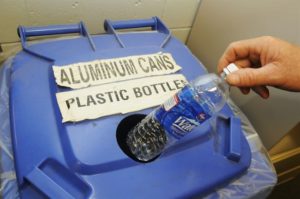 The good news is that action is being taken. The United States Congress passed a public health law in 2015 banning microbeads from cosmetic products. This ban will take effect in 2018. The State of Wisconsin banned the manufacture of products containing microbeads in 2018 and, in 2019, the Wisconsin ban will include the sale of any products containing microbeads.
The good news is that action is being taken. The United States Congress passed a public health law in 2015 banning microbeads from cosmetic products. This ban will take effect in 2018. The State of Wisconsin banned the manufacture of products containing microbeads in 2018 and, in 2019, the Wisconsin ban will include the sale of any products containing microbeads.
While that is great news, those bans do not cover microfibers or prevent other microplastics from entering the waterways. A single fleece jacket can release up to 250,000 plastic fibers over it’s useful lifetime. Unfortunately, because of the widespread use of synthetic materials, these pollutants will ultimately be found in more of our water resources. They will continue to raise questions and concerns for our natural resources and human health.
What can I do to help?
The Wisconsin Department of Natural Resources identifies the following ways people can begin to address this growing problem:
- Reduce the sources of these pollutantsSelect personal care products that are free from microbeads
- Do not flush plastic-containing materials such as diapers
- Add an aftermarket filter to your washing machine to collect microfibers from synthetic clothing
- Purchase products made without plastic, when possible
- Reuse existing plastic
- Use reusable cups and bottles
- Reuse plastic grocery bags or use cloth bags
- Recycling plastics
- Recycle plastics properly including plastic bags and monofilament fishing line
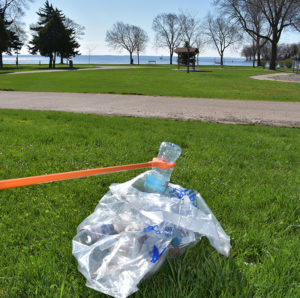 You can also help prevent existing plastic garbage from turning into microplastics by pick-up trash in and around our waterways. Fox-Wolf Watershed Alliance hosts a watershed cleanup every year with hundreds of volunteers who work to clean up our waterways. While the event is a blast and is great for our lakes and rivers, we can all do our part every day by picking up plastic litter and properly recycling our own plastic waste.
You can also help prevent existing plastic garbage from turning into microplastics by pick-up trash in and around our waterways. Fox-Wolf Watershed Alliance hosts a watershed cleanup every year with hundreds of volunteers who work to clean up our waterways. While the event is a blast and is great for our lakes and rivers, we can all do our part every day by picking up plastic litter and properly recycling our own plastic waste.
Over 400 microplastic particles are discharged from the Fond du Lac wastewater facility into Lake Winnebago alone. This does not account for the other wastewater facilities around Lake Winnebago or indirect sources such as plastic litter or surface water runoff.
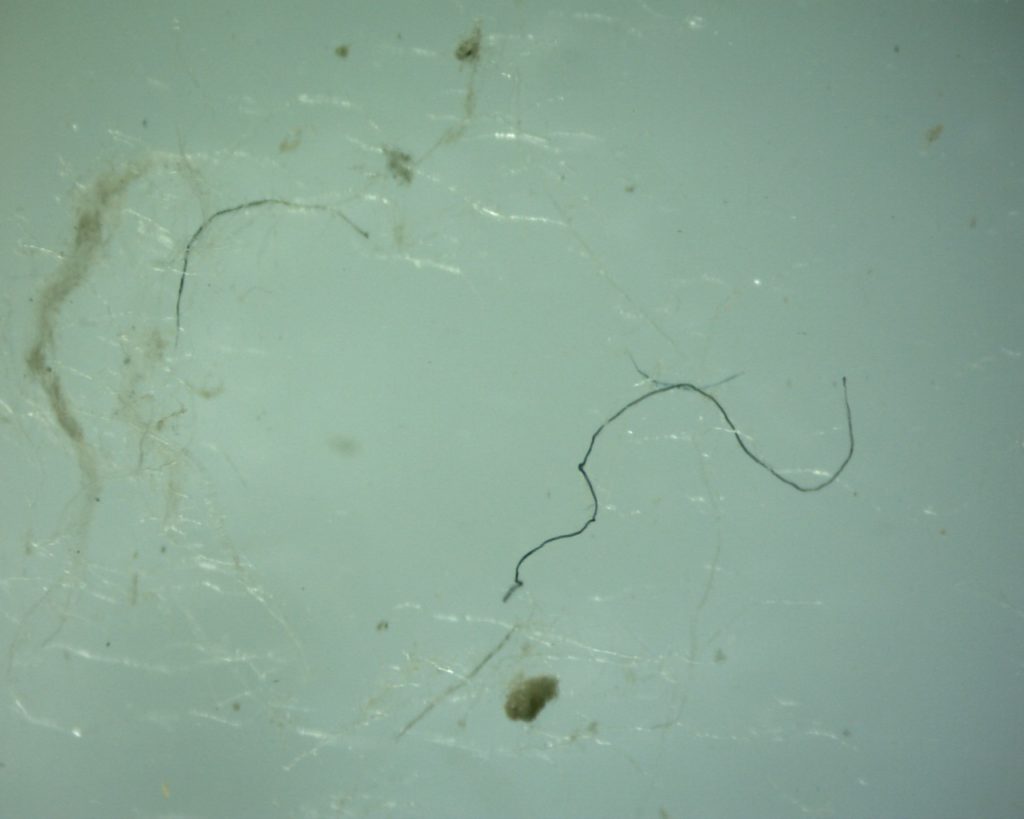
Microplastics from Fond du Lac WTRRF
Globally, over 60% of clothing is made of polyester. Polyseter is a form of plastic made popular because of its ability to breath, stretch, and wick moisture.
Concerned for the future of Lake Winnebago?
If you would like to get involved in helping to improve and protect the lakes within the Winnebago System, we invite you to participate in Lake Management Planning by signing up for a project Focus Group. Learn more by clicking here.
Photos from FWWA’s 2017 Watershed Cleanup
After initially being found in the North Atlantic Ocean in 1972, these pollutants are now being found in other bodies of water around the globe. The journal Environmental Science and Technology published a study in 2016, which showed microbeads had been discovered in many Great Lakes, including Great Lake tributaries. Click here to learn more.
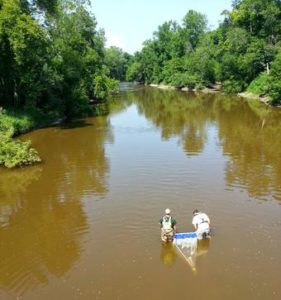
USGS scientists Pete Lenaker and Nic Buer collect a microplastic sample at the Manitowoc River, Manitowoc, Wisconsin. (Austin Baldwin, USGS, Public domain)
Want to learn more?
Check out this informative USGS website by clicking here.
Article written by: Korin Doering and Chad VandenLangenberg with assistance from Cheyenne Burchell. Thank you to Sarah Yang, Ph.D., Wisconsin Department of Natural Resources and Autumn Fisher, Fond du Lac Wastewater Treatment and Resource Recovery Facility, for your contributions to the article.

